文章目录
前言
这些天一直在尝试通过OpenPCDet平台训练自己的数据集(非kitti格式),好在最后终于跑通了,特此记录一下训练过程。
一、pcd转bin
笔者自己的点云数据是pcd格式的,参照kitti训练过程是需要转成bin格式的。
下面给出转换代码:
# -*- coding: utf-8 -*-
# @Time : 2022/7/25 11:30
# @Author : JulyLi
# @File : pcd2bin.py
import numpy as np
import os
import argparse
from pypcd import pypcd
import csv
from tqdm import tqdm
def main():
## Add parser
parser = argparse.ArgumentParser(description="Convert .pcd to .bin")
parser.add_argument(
"--pcd_path",
help=".pcd file path.",
type=str,
default="pcd_raw1"
)
parser.add_argument(
"--bin_path",
help=".bin file path.",
type=str,
default="bin"
)
parser.add_argument(
"--file_name",
help="File name.",
type=str,
default="file_name"
)
args = parser.parse_args()
## Find all pcd files
pcd_files = []
for (path, dir, files) in os.walk(args.pcd_path):
for filename in files:
# print(filename)
ext = os.path.splitext(filename)[-1]
if ext == '.pcd':
pcd_files.append(path + "/" + filename)
## Sort pcd files by file name
pcd_files.sort()
print("Finish to load point clouds!")
## Make bin_path directory
try:
if not (os.path.isdir(args.bin_path)):
os.makedirs(os.path.join(args.bin_path))
except OSError as e:
# if e.errno != errno.EEXIST:
# print("Failed to create directory!!!!!")
raise
## Generate csv meta file
csv_file_path = os.path.join(args.bin_path, "meta.csv")
csv_file = open(csv_file_path, "w")
meta_file = csv.writer(
csv_file, delimiter=",", quotechar="|", quoting=csv.QUOTE_MINIMAL
)
## Write csv meta file header
meta_file.writerow(
[
"pcd file name",
"bin file name",
]
)
print("Finish to generate csv meta file")
## Converting Process
print("Converting Start!")
seq = 0
for pcd_file in tqdm(pcd_files):
## Get pcd file
pc = pypcd.PointCloud.from_path(pcd_file)
## Generate bin file name
# bin_file_name = "{}_{:05d}.bin".format(args.file_name, seq)
bin_file_name = "{:05d}.bin".format(seq)
bin_file_path = os.path.join(args.bin_path, bin_file_name)
## Get data from pcd (x, y, z, intensity, ring, time)
np_x = (np.array(pc.pc_data['x'], dtype=np.float32)).astype(np.float32)
np_y = (np.array(pc.pc_data['y'], dtype=np.float32)).astype(np.float32)
np_z = (np.array(pc.pc_data['z'], dtype=np.float32)).astype(np.float32)
np_i = (np.array(pc.pc_data['intensity'], dtype=np.float32)).astype(np.float32) / 256
# np_r = (np.array(pc.pc_data['ring'], dtype=np.float32)).astype(np.float32)
# np_t = (np.array(pc.pc_data['time'], dtype=np.float32)).astype(np.float32)
## Stack all data
points_32 = np.transpose(np.vstack((np_x, np_y, np_z, np_i)))
## Save bin file
points_32.tofile(bin_file_path)
## Write csv meta file
meta_file.writerow(
[os.path.split(pcd_file)[-1], bin_file_name]
)
seq = seq + 1
if __name__ == "__main__":
main()
二、labelCloud 工具安装与使用
拉取源码
git clone https://github.com/ch-sa/labelCloud.git
安装依赖
pip install -r requirements.txt
启动程序
python labelCloud.py
启动后出现如下界面:
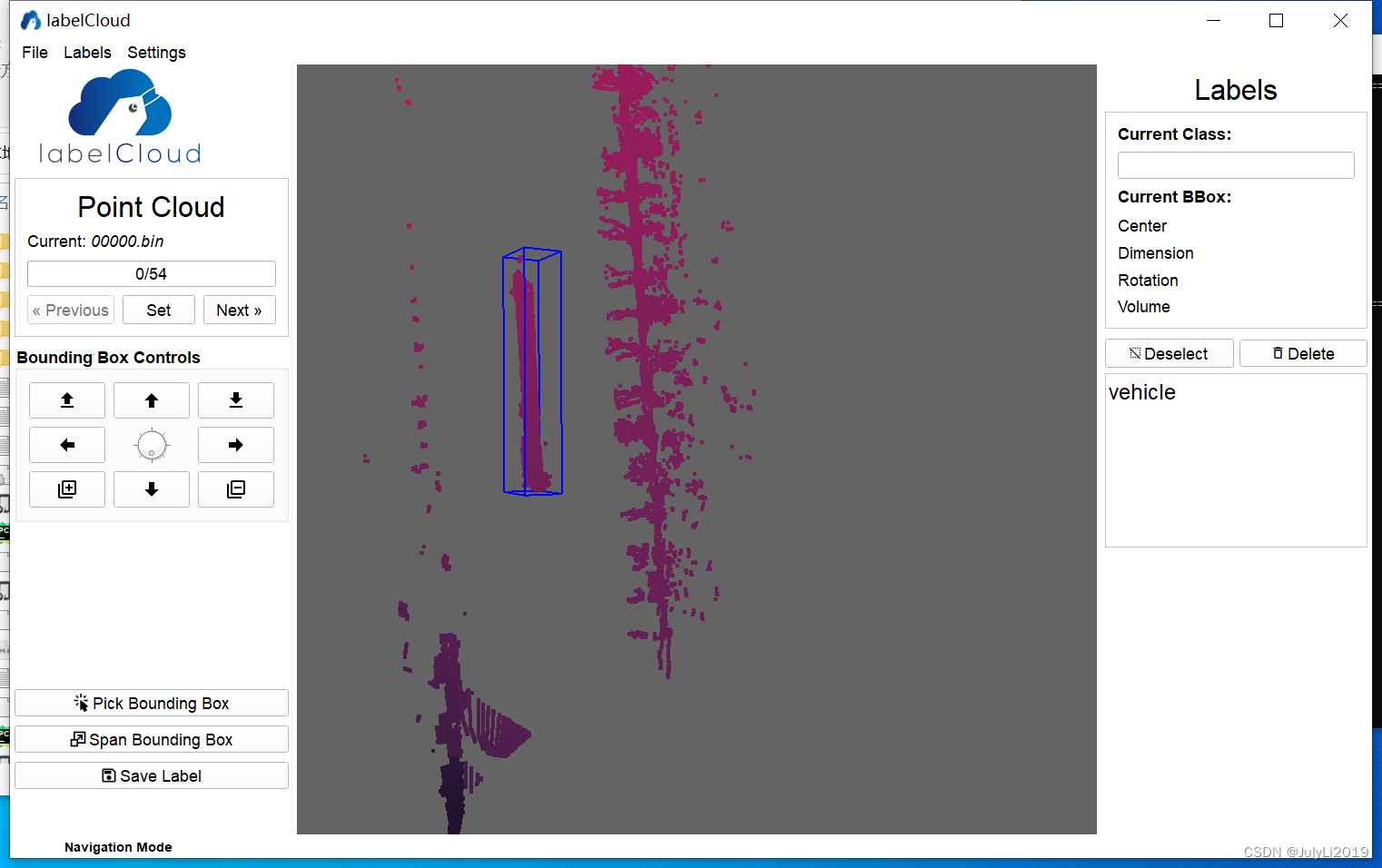
在setting界面按需设置,笔者这里按kitti格式生成label数据:

标注完成后会在对应目录下生成标签:
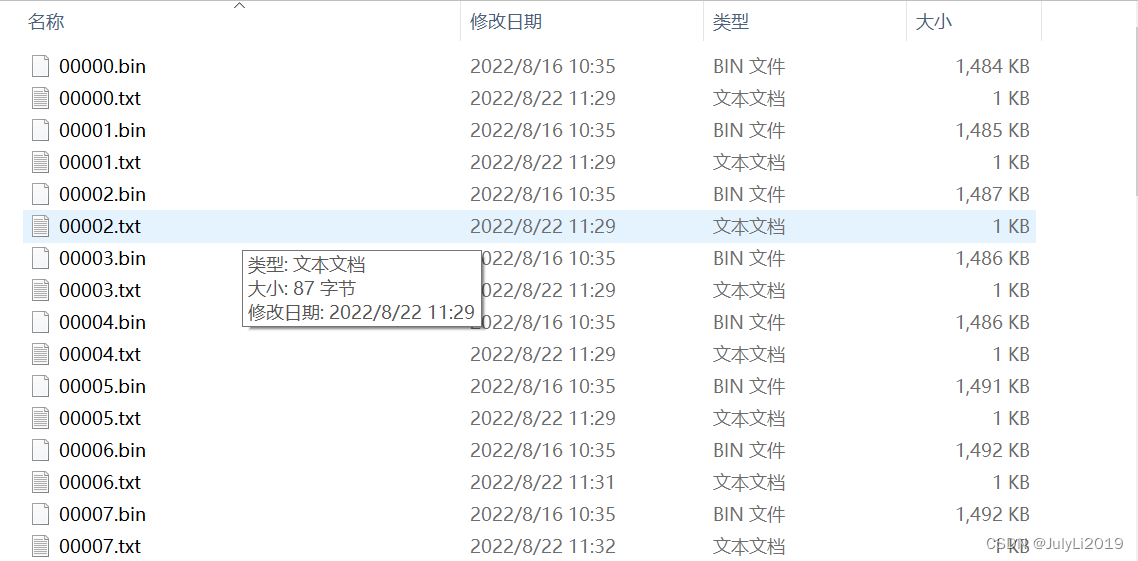
标签内容大致如下:
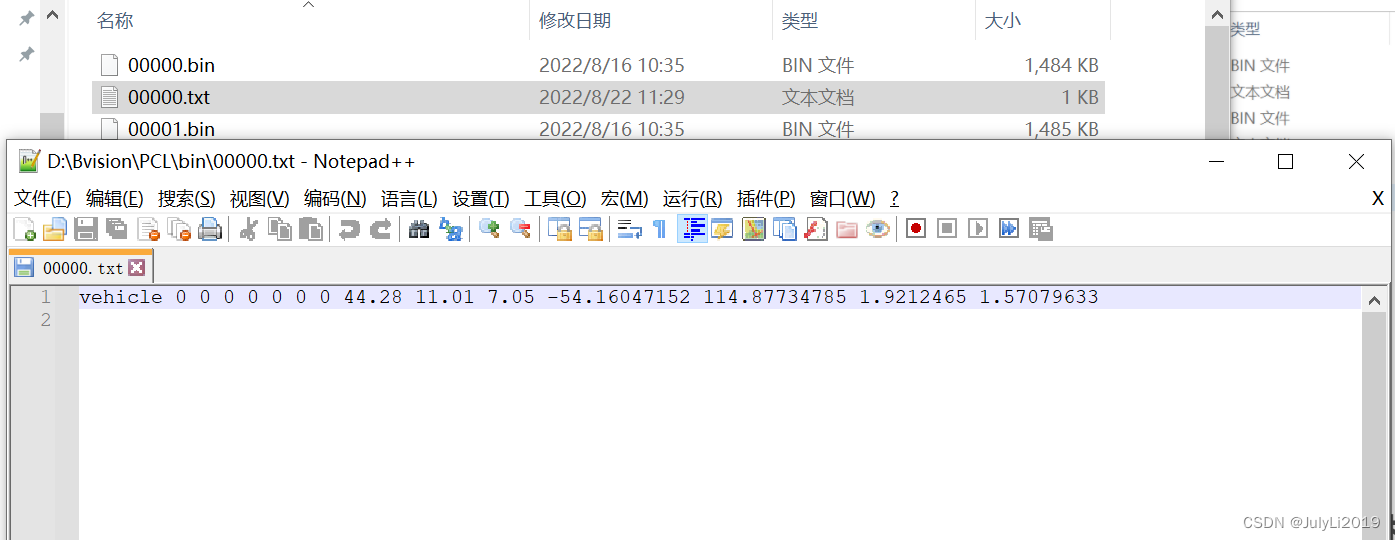
三、训练
仿写代码
把pcdet/datasets/kitti文件夹复制并改名为pcdet/datasets/custom,然后把pcdet/utils/object3d_kitti.py复制为pcdet/utils/object3d_custom.py
把data/kitti文件夹复制并改名为data/custom,然后修改训练信息,结构如下:
custom
├── ImageSets
│ ├── test.txt
│ ├── train.txt
├── testing
│ ├── velodyne
├── training
│ ├── label_2
│ ├── velodyne
对pcdet/datasets/custom/custom_dataset.py进行改写
import copy
import pickle
import os
import numpy as np
from skimage import io
from . import custom_utils
from ...ops.roiaware_pool3d import roiaware_pool3d_utils
from ...utils import box_utils, common_utils, object3d_custom
from ..dataset import DatasetTemplate
class CustomDataset(DatasetTemplate):
def __init__(self, dataset_cfg, class_names, training=True, root_path=None, logger=None, ext='.bin'):
"""
Args:
root_path:
dataset_cfg:
class_names:
training:
logger:
"""
super().__init__(
dataset_cfg=dataset_cfg, class_names=class_names, training=training, root_path=root_path, logger=logger
)
self.split = self.dataset_cfg.DATA_SPLIT[self.mode]
self.root_split_path = os.path.join(self.root_path, ('training' if self.split != 'test' else 'testing'))
split_dir = os.path.join(self.root_path, 'ImageSets',(self.split + '.txt'))
self.sample_id_list = [x.strip() for x in open(split_dir).readlines()] if os.path.exists(split_dir) else None
self.custom_infos = []
self.include_custom_data(self.mode)
self.ext = ext
def include_custom_data(self, mode):
if self.logger is not None:
self.logger.info('Loading Custom dataset.')
custom_infos = []
for info_path in self.dataset_cfg.INFO_PATH[mode]:
info_path = self.root_path / info_path
if not info_path.exists():
continue
with open(info_path, 'rb') as f:
infos = pickle.load(f)
custom_infos.extend(infos)
self.custom_infos.extend(custom_infos)
if self.logger is not None:
self.logger.info('Total samples for CUSTOM dataset: %d' % (len(custom_infos)))
def get_infos(self, num_workers=16, has_label=True, count_inside_pts=True, sample_id_list=None):
import concurrent.futures as futures
# Process single scene
def process_single_scene(sample_idx):
print('%s sample_idx: %s' % (self.split, sample_idx))
# define an empty dict
info = {}
# pts infos: dimention and idx
pc_info = {'num_features': 4, 'lidar_idx': sample_idx}
# add to pts infos
info['point_cloud'] = pc_info
# no images, calibs are need to transform the labels
type_to_id = {'Car': 1, 'Pedestrian': 2, 'Cyclist': 3}
if has_label:
# read labels to build object list according to idx
obj_list = self.get_label(sample_idx)
# build an empty annotations dict
annotations = {}
# add to annotations ==> refer to 'object3d_custom' (no truncated,occluded,alpha,bbox)
annotations['name'] = np.array([obj.cls_type for obj in obj_list]) # 1-dimension
# hwl(camera) format 2-dimension: The kitti-labels are in camera-coord
# h,w,l -> 0.21,0.22,0.33 (see object3d_custom.py h=label[8], w=label[9], l=label[10])
annotations['dimensions'] = np.array([[obj.l, obj.h, obj.w] for obj in obj_list])
annotations['location'] = np.concatenate([obj.loc.reshape(1,3) for obj in obj_list])
annotations['rotation_y'] = np.array([obj.ry for obj in obj_list]) # 1-dimension
num_objects = len([obj.cls_type for obj in obj_list if obj.cls_type != 'DontCare'])
num_gt = len(annotations['name'])
index = list(range(num_objects)) + [-1] * (num_gt - num_objects)
annotations['index'] = np.array(index, dtype=np.int32)
loc = annotations['location'][:num_objects]
dims = annotations['dimensions'][:num_objects]
rots = annotations['rotation_y'][:num_objects]
# camera -> lidar: The points of custom_dataset are already in lidar-coord
# But the labels are in camera-coord and need to transform
loc_lidar = self.get_calib(loc)
l, h, w = dims[:, 0:1], dims[:, 1:2], dims[:, 2:3]
# bottom center -> object center: no need for loc_lidar[:, 2] += h[:, 0] / 2
# print("sample_idx: ", sample_idx, "loc: ", loc, "loc_lidar: " , sample_idx, loc_lidar)
# get gt_boxes_lidar see https://zhuanlan.zhihu.com/p/152120636
gt_boxes_lidar = np.concatenate([loc_lidar, l, w, h, (np.pi / 2 - rots[..., np.newaxis])], axis=1) # 2-dimension array
annotations['gt_boxes_lidar'] = gt_boxes_lidar
# add annotation info
info['annos'] = annotations
return info
sample_id_list = sample_id_list if sample_id_list is not None else self.sample_id_list
# create a thread pool to improve the velocity
with futures.ThreadPoolExecutor(num_workers) as executor:
infos = executor.map(process_single_scene, sample_id_list)
# infos is a list that each element represents per frame
return list(infos)
def get_calib(self, loc):
"""
This calibration is different from the kitti dataset.
The transform formual of labelCloud: ROOT/labelCloud/io/labels/kitti.py: import labels
if self.transformed:
centroid = centroid[2], -centroid[0], centroid[1] - 2.3
dimensions = [float(v) for v in line_elements[8:11]]
if self.transformed:
dimensions = dimensions[2], dimensions[1], dimensions[0]
bbox = BBox(*centroid, *dimensions)
"""
loc_lidar = np.concatenate([np.array((float(loc_obj[2]), float(-loc_obj[0]), float(loc_obj[1]-2.3)), dtype=np.float32).reshape(1,3) for loc_obj in loc])
return loc_lidar
def get_label(self, idx):
# get labels
label_file = self.root_split_path / 'label_2' / ('%s.txt' % idx)
assert label_file.exists()
return object3d_custom.get_objects_from_label(label_file)
def get_lidar(self, idx, getitem):
"""
Loads point clouds for a sample
Args:
index (int): Index of the point cloud file to get.
Returns:
np.array(N, 4): point cloud.
"""
# get lidar statistics
if getitem == True:
lidar_file = self.root_split_path + '/velodyne/' + ('%s.bin' % idx)
else:
lidar_file = self.root_split_path / 'velodyne' / ('%s.bin' % idx)
return np.fromfile(str(lidar_file), dtype=np.float32).reshape(-1, 4)
def set_split(self, split):
super().__init__(
dataset_cfg=self.dataset_cfg, class_names=self.class_names, training=self.training, root_path=self.root_path, logger=self.logger
)
self.split = split
self.root_split_path = self.root_path / ('training' if self.split != 'test' else 'testing')
split_dir = self.root_path / 'ImageSets' / (self.split + '.txt')
self.sample_id_list = [x.strip() for x in open(split_dir).readlines()] if split_dir.exists() else None
# Create gt database for data augmentation
def create_groundtruth_database(self, info_path=None, used_classes=None, split='train'):
import torch
# Specify the direction
database_save_path = Path(self.root_path) / ('gt_database' if split == 'train' else ('gt_database_%s' % split))
db_info_save_path = Path(self.root_path) / ('custom_dbinfos_%s.pkl' % split)
database_save_path.mkdir(parents=True, exist_ok=True)
all_db_infos = {}
# Open 'custom_train_info.pkl'
with open(info_path, 'rb') as f:
infos = pickle.load(f)
# For each .bin file
for k in range(len(infos)):
print('gt_database sample: %d/%d' % (k + 1, len(infos)))
# Get current scene info
info = infos[k]
sample_idx = info['point_cloud']['lidar_idx']
points = self.get_lidar(sample_idx, False)
annos = info['annos']
names = annos['name']
gt_boxes = annos['gt_boxes_lidar']
num_obj = gt_boxes.shape[0]
point_indices = roiaware_pool3d_utils.points_in_boxes_cpu(
torch.from_numpy(points[:, 0:3]), torch.from_numpy(gt_boxes)
).numpy() # (nboxes, npoints)
for i in range(num_obj):
filename = '%s_%s_%d.bin' % (sample_idx, names[i], i)
filepath = database_save_path / filename
gt_points = points[point_indices[i] > 0]
gt_points[:, :3] -= gt_boxes[i, :3]
with open(filepath, 'w') as f:
gt_points.tofile(f)
if (used_classes is None) or names[i] in used_classes:
db_path = str(filepath.relative_to(self.root_path)) # gt_database/xxxxx.bin
db_info = {'name': names[i], 'path': db_path, 'gt_idx': i,
'box3d_lidar': gt_boxes[i], 'num_points_in_gt': gt_points.shape[0]}
if names[i] in all_db_infos:
all_db_infos[names[i]].append(db_info)
else:
all_db_infos[names[i]] = [db_info]
# Output the num of all classes in database
for k, v in all_db_infos.items():
print('Database %s: %d' % (k, len(v)))
with open(db_info_save_path, 'wb') as f:
pickle.dump(all_db_infos, f)
@staticmethod
def generate_prediction_dicts(batch_dict, pred_dicts, class_names, output_path=None):
"""
Args:
batch_dict:
frame_id:
pred_dicts: list of pred_dicts
pred_boxes: (N,7), Tensor
pred_scores: (N), Tensor
pred_lables: (N), Tensor
class_names:
output_path:
Returns:
"""
def get_template_prediction(num_smaples):
ret_dict = {
'name': np.zeros(num_smaples), 'alpha' : np.zeros(num_smaples),
'dimensions': np.zeros([num_smaples, 3]), 'location': np.zeros([num_smaples, 3]),
'rotation_y': np.zero(num_smaples), 'score': np.zeros(num_smaples),
'boxes_lidar': np.zeros([num_smaples, 7])
}
return ret_dict
def generate_single_sample_dict(batch_index, box_dict):
pred_scores = box_dict['pred_scores'].cpu().numpy()
pred_boxes = box_dict['pred_boxes'].cpu().numpy()
pred_labels = box_dict['pred_labels'].cpu().numpy()
# Define an empty template dict to store the prediction information, 'pred_scores.shape[0]' means 'num_samples'
pred_dict = get_template_prediction(pred_scores.shape[0])
# If num_samples equals zero then return the empty dict
if pred_scores.shape[0] == 0:
return pred_dict
# No calibration files
pred_boxes_camera = box_utils.boxes3d_lidar_to_kitti_camera[pred_boxes]
pred_dict['name'] = np.array(class_names)[pred_labels - 1]
pred_dict['alpha'] = -np.arctan2(-pred_boxes[:, 1], pred_boxes[:, 0]) + pred_boxes_camera[:, 6]
pred_dict['dimensions'] = pred_boxes_camera[:, 3:6]
pred_dict['location'] = pred_boxes_camera[:, 0:3]
pred_dict['rotation_y'] = pred_boxes_camera[:, 6]
pred_dict['score'] = pred_scores
pred_dict['boxes_lidar'] = pred_boxes
return pred_dict
annos = []
for index, box_dict in enumerate(pred_dicts):
frame_id = batch_dict['frame_id'][index]
single_pred_dict = generate_single_sample_dict(index, box_dict)
single_pred_dict['frame_id'] = frame_id
annos.append(single_pred_dict)
# Output pred results to Output-path in .txt file
if output_path is not None:
cur_det_file = output_path / ('%s.txt' % frame_id)
with open(cur_det_file, 'w') as f:
bbox = single_pred_dict['bbox']
loc = single_pred_dict['location']
dims = single_pred_dict['dimensions'] # lhw -> hwl: lidar -> camera
for idx in range(len(bbox)):
print('%s -1 -1 %.4f %.4f %.4f %.4f %.4f %.4f %.4f %.4f %.4f %.4f %.4f %.4f %.4f'
% (single_pred_dict['name'][idx], single_pred_dict['alpha'][idx],
bbox[idx][0], bbox[idx][1], bbox[idx][2], bbox[idx][3],
dims[idx][1], dims[idx][2], dims[idx][0], loc[idx][0],
loc[idx][1], loc[idx][2], single_pred_dict['rotation_y'][idx],
single_pred_dict['score'][idx]), file=f)
return annos
def __len__(self):
if self._merge_all_iters_to_one_epoch:
return len(self.sample_id_list) * self.total_epochs
return len(self.custom_infos)
def __getitem__(self, index):
"""
Function:
Read 'velodyne' folder as pointclouds
Read 'label_2' folder as labels
Return type 'dict'
"""
if self._merge_all_iters_to_one_epoch:
index = index % len(self.custom_infos)
info = copy.deepcopy(self.custom_infos[index])
sample_idx = info['point_cloud']['lidar_idx']
get_item_list = self.dataset_cfg.get('GET_ITEM_LIST', ['points'])
input_dict = {
'frame_id': self.sample_id_list[index],
}
"""
Here infos was generated by get_infos
"""
if 'annos' in info:
annos = info['annos']
annos = common_utils.drop_info_with_name(annos, name='DontCare')
loc, dims, rots = annos['location'], annos['dimensions'], annos['rotation_y']
gt_names = annos['name']
gt_boxes_lidar = annos['gt_boxes_lidar']
if 'points' in get_item_list:
points = self.get_lidar(sample_idx, True)
# import time
# print(points.shape)
# if points.shape[0] == 0:
# print("**********************************")
# print("sample_idx: ", sample_idx)
# time.sleep(999999)
# print("**********************************")
# 000099, 000009
input_dict['points'] = points
input_dict.update({
'gt_names': gt_names,
'gt_boxes': gt_boxes_lidar
})
data_dict = self.prepare_data(data_dict=input_dict)
return data_dict
def create_custom_infos(dataset_cfg, class_names, data_path, save_path, workers=4):
dataset = CustomDataset(dataset_cfg=dataset_cfg, class_names=class_names, root_path=data_path, training=False)
train_split, val_split = 'train', 'val'
# No evaluation
train_filename = save_path / ('custom_infos_%s.pkl' % train_split)
val_filenmae = save_path / ('custom_infos%s.pkl' % val_split)
trainval_filename = save_path / 'custom_infos_trainval.pkl'
test_filename = save_path / 'custom_infos_test.pkl'
print('------------------------Start to generate data infos------------------------')
dataset.set_split(train_split)
custom_infos_train = dataset.get_infos(num_workers=workers, has_label=True, count_inside_pts=True)
with open(train_filename, 'wb') as f:
pickle.dump(custom_infos_train, f)
print('Custom info train file is save to %s' % train_filename)
dataset.set_split('test')
custom_infos_test = dataset.get_infos(num_workers=workers, has_label=False, count_inside_pts=False)
with open(test_filename, 'wb') as f:
pickle.dump(custom_infos_test, f)
print('Custom info test file is saved to %s' % test_filename)
print('------------------------Start create groundtruth database for data augmentation------------------------')
dataset.set_split(train_split)
# Input the 'custom_train_info.pkl' to generate gt_database
dataset.create_groundtruth_database(train_filename, split=train_split)
print('------------------------Data preparation done------------------------')
if __name__=='__main__':
import sys
if sys.argv.__len__() > 1 and sys.argv[1] == 'create_custom_infos':
import yaml
from pathlib import Path
from easydict import EasyDict
dataset_cfg = EasyDict(yaml.safe_load(open(sys.argv[2])))
ROOT_DIR = (Path(__file__).resolve().parent / '../../../').resolve()
create_custom_infos(
dataset_cfg=dataset_cfg,
class_names=['Car', 'Pedestrian', 'Cyclist'],
data_path=ROOT_DIR / 'data' / 'custom',
save_path=ROOT_DIR / 'data' / 'custom'
)
新建tools/cfgs/dataset_configs/custom_dataset.yaml并修改
DATASET: 'CustomDataset'
DATA_PATH: '../data/custom'
# If this config file is modified then pcdet/models/detectors/detector3d_template.py:
# Detector3DTemplate::build_networks:model_info_dict needs to be modified.
POINT_CLOUD_RANGE: [-70.4, -40, -3, 70.4, 40, 1] # x=[-70.4, 70.4], y=[-40,40], z=[-3,1]
DATA_SPLIT: {
'train': train,
'test': val
}
INFO_PATH: {
'train': [custom_infos_train.pkl],
'test': [custom_infos_val.pkl],
}
GET_ITEM_LIST: ["points"]
FOV_POINTS_ONLY: True
POINT_FEATURE_ENCODING: {
encoding_type: absolute_coordinates_encoding,
used_feature_list: ['x', 'y', 'z', 'intensity'],
src_feature_list: ['x', 'y', 'z', 'intensity'],
}
# Same to pv_rcnn[DATA_AUGMENTOR]
DATA_AUGMENTOR:
DISABLE_AUG_LIST: ['placeholder']
AUG_CONFIG_LIST:
- NAME: gt_sampling
# Notice that 'USE_ROAD_PLANE'
USE_ROAD_PLANE: False
DB_INFO_PATH:
- custom_dbinfos_train.pkl # pcdet/datasets/augmentor/database_ampler.py:line 26
PREPARE: {
filter_by_min_points: ['Car:5', 'Pedestrian:5', 'Cyclist:5'],
filter_by_difficulty: [-1],
}
SAMPLE_GROUPS: ['Car:20','Pedestrian:15', 'Cyclist:15']
NUM_POINT_FEATURES: 4
DATABASE_WITH_FAKELIDAR: False
REMOVE_EXTRA_WIDTH: [0.0, 0.0, 0.0]
LIMIT_WHOLE_SCENE: True
- NAME: random_world_flip
ALONG_AXIS_LIST: ['x']
- NAME: random_world_rotation
WORLD_ROT_ANGLE: [-0.78539816, 0.78539816]
- NAME: random_world_scaling
WORLD_SCALE_RANGE: [0.95, 1.05]
DATA_PROCESSOR:
- NAME: mask_points_and_boxes_outside_range
REMOVE_OUTSIDE_BOXES: True
- NAME: shuffle_points
SHUFFLE_ENABLED: {
'train': True,
'test': False
}
- NAME: transform_points_to_voxels
VOXEL_SIZE: [0.05, 0.05, 0.1]
MAX_POINTS_PER_VOXEL: 5
MAX_NUMBER_OF_VOXELS: {
'train': 16000,
'test': 40000
}
新建tools/cfgs/custom_models/pointrcnn.yaml并修改
CLASS_NAMES: ['Car']
# CLASS_NAMES: ['Car', 'Pedestrian', 'Cyclist']
DATA_CONFIG:
_BASE_CONFIG_: /home/zonlin/CRLFnet/src/site_model/src/LidCamFusion/OpenPCDet/tools/cfgs/dataset_configs/custom_dataset.yaml
_BASE_CONFIG_RT_: /home/zonlin/CRLFnet/src/site_model/src/LidCamFusion/OpenPCDet/tools/cfgs/dataset_configs/custom_dataset.yaml
DATA_PROCESSOR:
- NAME: mask_points_and_boxes_outside_range
REMOVE_OUTSIDE_BOXES: True
- NAME: sample_points
NUM_POINTS: {
'train': 16384,
'test': 16384
}
- NAME: shuffle_points
SHUFFLE_ENABLED: {
'train': True,
'test': False
}
MODEL:
NAME: PointRCNN
BACKBONE_3D:
NAME: PointNet2MSG
SA_CONFIG:
NPOINTS: [4096, 1024, 256, 64]
RADIUS: [[0.1, 0.5], [0.5, 1.0], [1.0, 2.0], [2.0, 4.0]]
NSAMPLE: [[16, 32], [16, 32], [16, 32], [16, 32]]
MLPS: [[[16, 16, 32], [32, 32, 64]],
[[64, 64, 128], [64, 96, 128]],
[[128, 196, 256], [128, 196, 256]],
[[256, 256, 512], [256, 384, 512]]]
FP_MLPS: [[128, 128], [256, 256], [512, 512], [512, 512]]
POINT_HEAD:
NAME: PointHeadBox
CLS_FC: [256, 256]
REG_FC: [256, 256]
CLASS_AGNOSTIC: False
USE_POINT_FEATURES_BEFORE_FUSION: False
TARGET_CONFIG:
GT_EXTRA_WIDTH: [0.2, 0.2, 0.2]
BOX_CODER: PointResidualCoder
BOX_CODER_CONFIG: {
'use_mean_size': True,
'mean_size': [
[3.9, 1.6, 1.56],
[0.8, 0.6, 1.73],
[1.76, 0.6, 1.73]
]
}
LOSS_CONFIG:
LOSS_REG: WeightedSmoothL1Loss
LOSS_WEIGHTS: {
'point_cls_weight': 1.0,
'point_box_weight': 1.0,
'code_weights': [1.0, 1.0, 1.0, 1.0, 1.0, 1.0, 1.0, 1.0]
}
ROI_HEAD:
NAME: PointRCNNHead
CLASS_AGNOSTIC: True
ROI_POINT_POOL:
POOL_EXTRA_WIDTH: [0.0, 0.0, 0.0]
NUM_SAMPLED_POINTS: 512
DEPTH_NORMALIZER: 70.0
XYZ_UP_LAYER: [128, 128]
CLS_FC: [256, 256]
REG_FC: [256, 256]
DP_RATIO: 0.0
USE_BN: False
SA_CONFIG:
NPOINTS: [128, 32, -1]
RADIUS: [0.2, 0.4, 100]
NSAMPLE: [16, 16, 16]
MLPS: [[128, 128, 128],
[128, 128, 256],
[256, 256, 512]]
NMS_CONFIG:
TRAIN:
NMS_TYPE: nms_gpu
MULTI_CLASSES_NMS: False
NMS_PRE_MAXSIZE: 9000
NMS_POST_MAXSIZE: 512
NMS_THRESH: 0.8
TEST:
NMS_TYPE: nms_gpu
MULTI_CLASSES_NMS: False
NMS_PRE_MAXSIZE: 9000
NMS_POST_MAXSIZE: 100
NMS_THRESH: 0.85
TARGET_CONFIG:
BOX_CODER: ResidualCoder
ROI_PER_IMAGE: 128
FG_RATIO: 0.5
SAMPLE_ROI_BY_EACH_CLASS: True
CLS_SCORE_TYPE: cls
CLS_FG_THRESH: 0.6
CLS_BG_THRESH: 0.45
CLS_BG_THRESH_LO: 0.1
HARD_BG_RATIO: 0.8
REG_FG_THRESH: 0.55
LOSS_CONFIG:
CLS_LOSS: BinaryCrossEntropy
REG_LOSS: smooth-l1
CORNER_LOSS_REGULARIZATION: True
LOSS_WEIGHTS: {
'rcnn_cls_weight': 1.0,
'rcnn_reg_weight': 1.0,
'rcnn_corner_weight': 1.0,
'code_weights': [1.0, 1.0, 1.0, 1.0, 1.0, 1.0, 1.0]
}
POST_PROCESSING:
RECALL_THRESH_LIST: [0.3, 0.5, 0.7]
SCORE_THRESH: 0.1
OUTPUT_RAW_SCORE: False
EVAL_METRIC: kitti
NMS_CONFIG:
MULTI_CLASSES_NMS: False
NMS_TYPE: nms_gpu
NMS_THRESH: 0.1
NMS_PRE_MAXSIZE: 4096
NMS_POST_MAXSIZE: 500
OPTIMIZATION:
BATCH_SIZE_PER_GPU: 2
NUM_EPOCHS: 80
OPTIMIZER: adam_onecycle
LR: 0.01
WEIGHT_DECAY: 0.01
MOMENTUM: 0.9
MOMS: [0.95, 0.85]
PCT_START: 0.4
DIV_FACTOR: 10
DECAY_STEP_LIST: [35, 45]
LR_DECAY: 0.1
LR_CLIP: 0.0000001
LR_WARMUP: False
WARMUP_EPOCH: 1
GRAD_NORM_CLIP: 10
其他调整事项
需要对以上文件中的类别信息,数据集路径,点云范围POINT_CLOUD_RANGE进行更改
在 pcdet/datasets/init.py文件,增加以下代码
from .custom.custom_dataset import CustomDataset
# 在__all__ = 中增加
'CustomDataset': CustomDataset
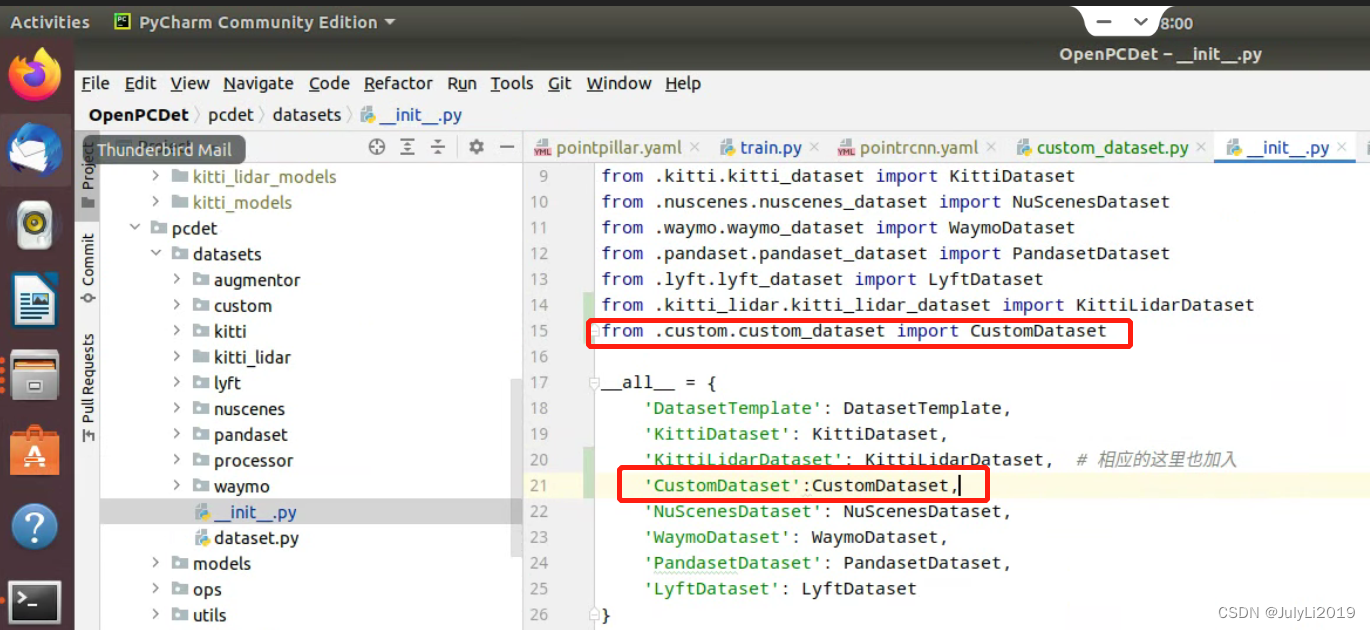
完成以上就可以开始对数据集进行预处理和训练了
数据集预处理
python -m pcdet.datasets.custom.custom_dataset create_custom_infos tools/cfgs/dataset_configs/custom_dataset.yaml

同时在gt_database文件夹下生成的.bin文件,data/custom文件夹结构变为如下:
custom
├── ImageSets
│ ├── test.txt
│ ├── train.txt
├── testing
│ ├── velodyne
├── training
│ ├── label_2
│ ├── velodyne
├── gt_database
│ ├── xxxxx.bin
├── custom_infos_train.pkl
├── custom_infos_val.pkl
├── custom_dbinfos_train.pkl
数据集训练
python tools/train.py --cfg_file tools/cfgs/custom_models/pointrcnn.yaml --batch_size=2 --epochs=300
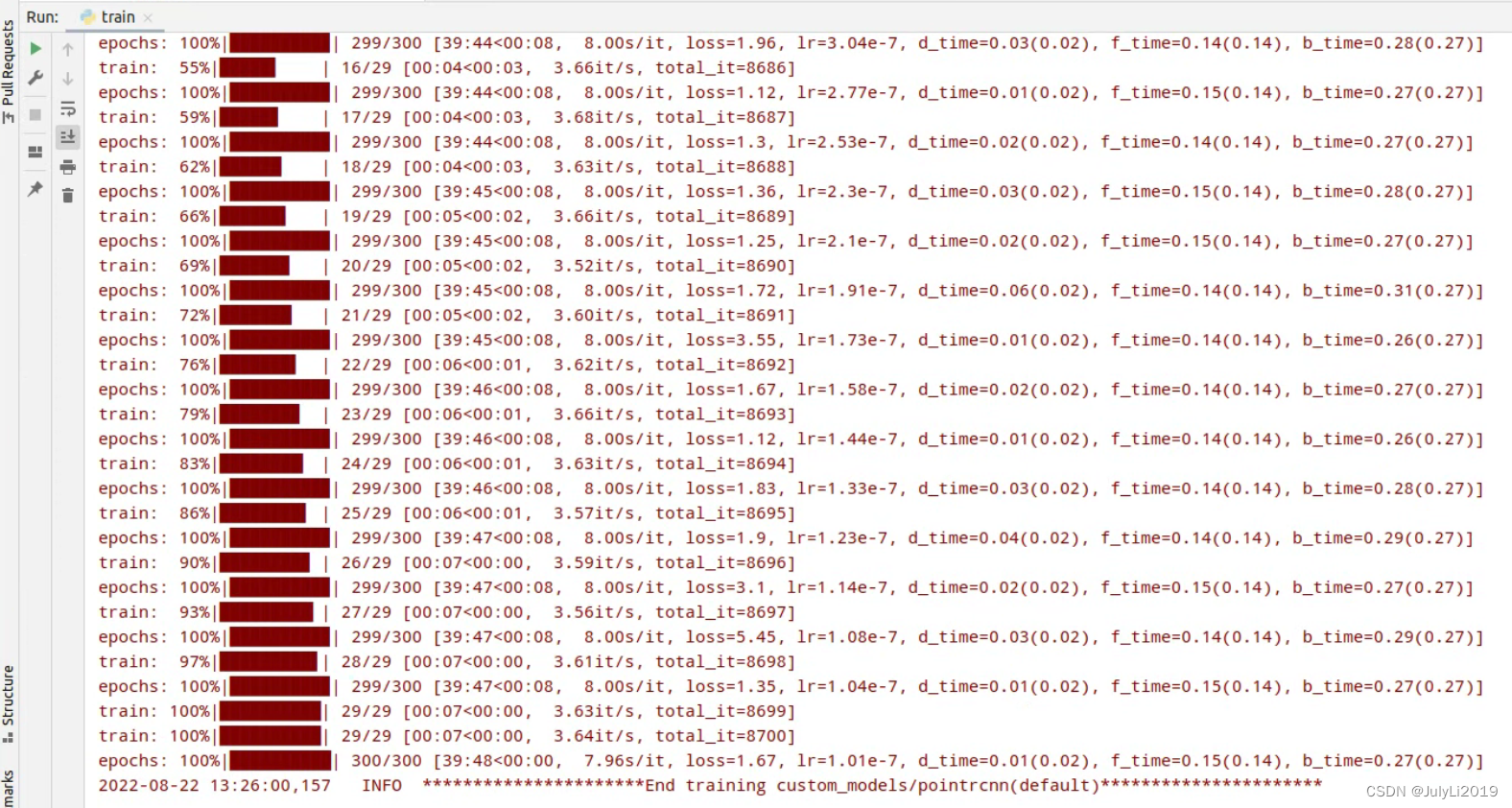
可视化测试
cd到tools文件夹下,运行:
python demo.py --cfg_file cfgs/custom_models/pointrcnn.yaml --data_path ../data/custom/testinging/velodyne/ --ckpt ../output/custom_models/pointrcnn/default/ckpt/checkpoint_epoch_300.pth
此处根据自己的文件路径进行修改,推理效果如下(笔者标注50多张闸口船舶的点云数据):
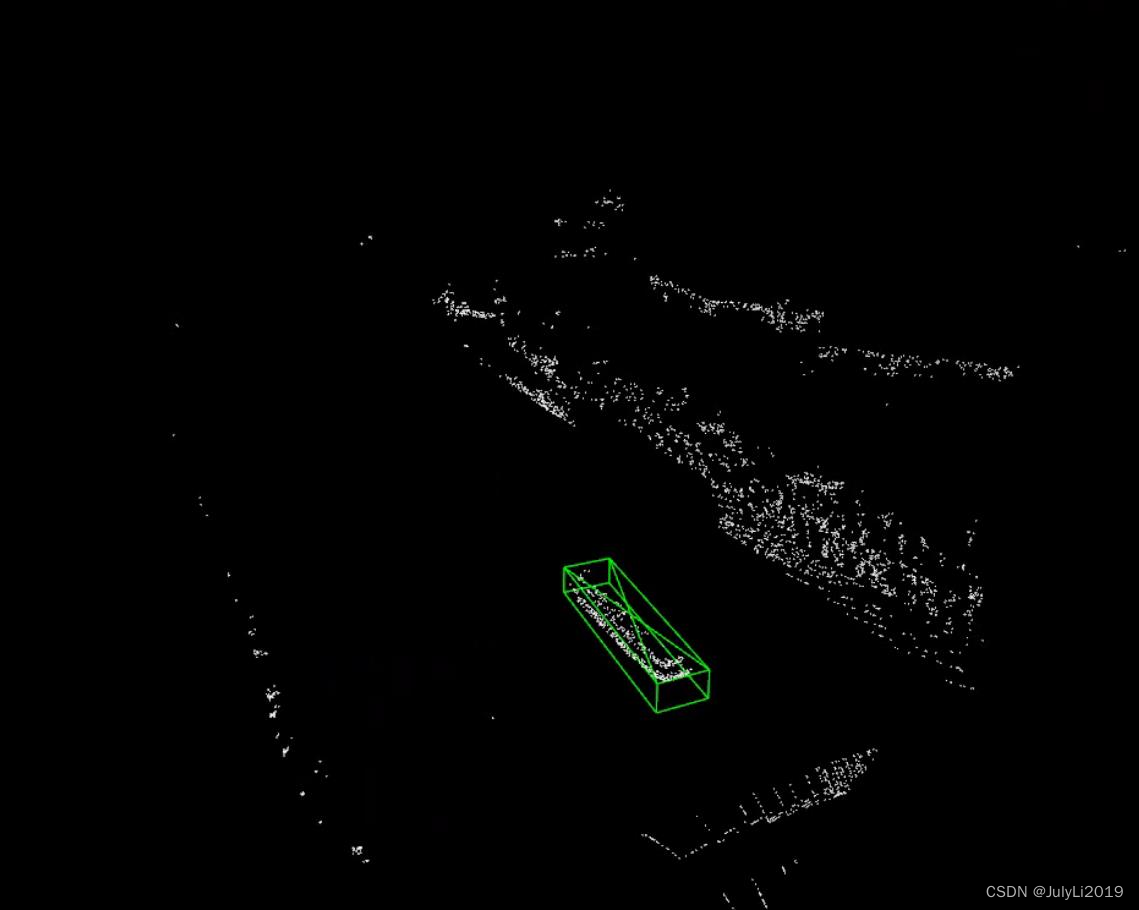
看起来效果还是挺不错。
获取尺寸
OpenPCDet平台下根据kitti格式推理得到的bbox的dx、dy、dz就是约等于实际的物体的尺寸。
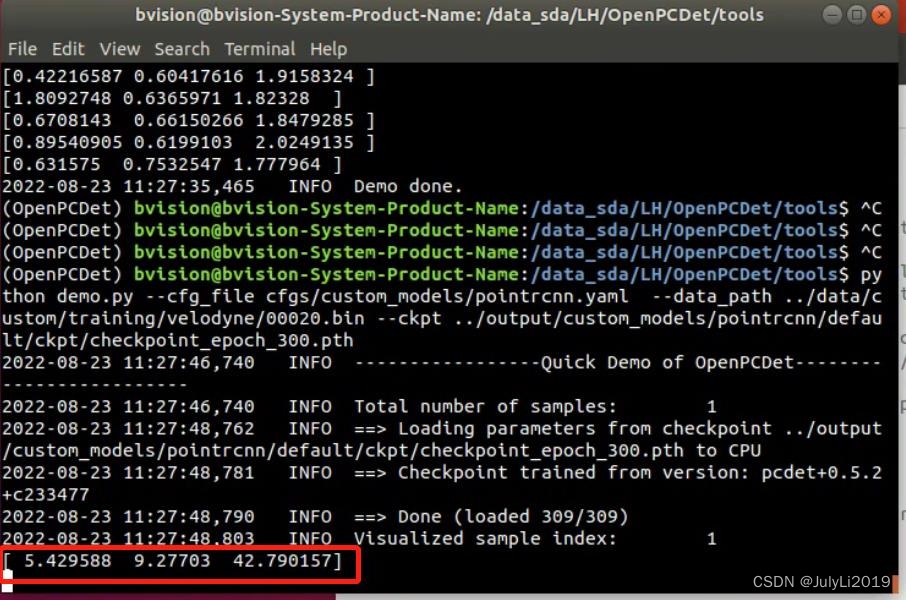
对于我们的点云数据而言,上述数据对应船的高宽长。(这里不理解的可以去看下OpenPCDet的坐标定义)
四、总结
至此,基于OpenPCDet平台的自定义数据集的训练基本完成了,这里要特别感谢下树和猫,对于自定义数据集的训练我们交流了很多,之前他是通过我写的yolov5系列文章关注的我,现在我通过OpenPCDet 训练自己的数据集系列关注了他,着实让我感觉到了技术分享是一个圈。
参考文档:
https://blog.csdn.net/m0_68312479/article/details/126201450
https://blog.csdn.net/jin15203846657/article/details/122949271
https://blog.csdn.net/hihui1231/article/details/124903276
https://github.com/OrangeSodahub/CRLFnet/tree/master/src/site_model/src/LidCamFusion/OpenPCDet
https://blog.csdn.net/weixin_43464623/article/details/116718451
如果阅读本文对你有用,欢迎一键三连呀!!!
2022年10月24日11:12:53

文章出处登录后可见!
